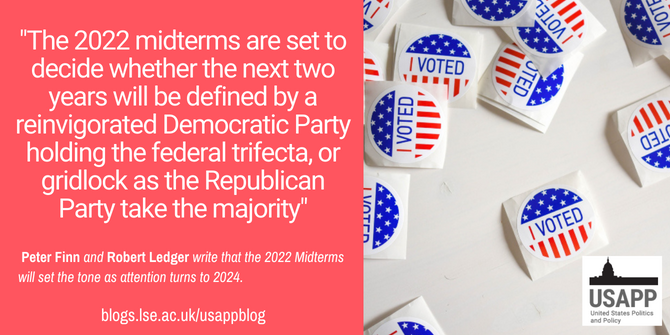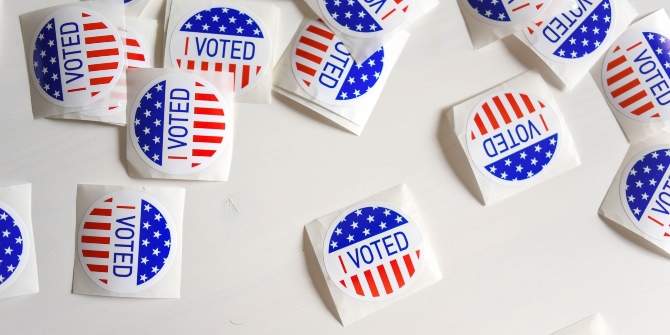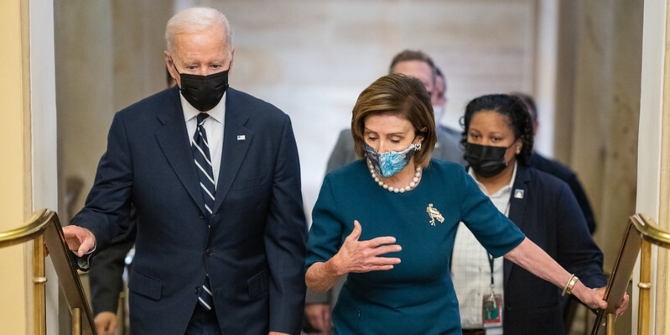
 As the first Biden Administration approaches its halfway point, the 2022 midterms are, at a federal level at least, set to decide whether the next two years will be defined by a reinvigorated Democratic Party holding the federal trifecta, or gridlock as the Republican Party take the majority in either or both chambers of the US Congress. Drawing on “The 2022 Midterms” series, Peter Finn and Robert Ledger highlight the value of thinking beyond any election cycle, map the shapes Washington DC may take between 2023-2025, and highlight some states and races worthy of particular attention.
As the first Biden Administration approaches its halfway point, the 2022 midterms are, at a federal level at least, set to decide whether the next two years will be defined by a reinvigorated Democratic Party holding the federal trifecta, or gridlock as the Republican Party take the majority in either or both chambers of the US Congress. Drawing on “The 2022 Midterms” series, Peter Finn and Robert Ledger highlight the value of thinking beyond any election cycle, map the shapes Washington DC may take between 2023-2025, and highlight some states and races worthy of particular attention.
- Looking ahead to elections across the US in 2022, our mini-series, ‘The 2022 midterms‘, explores aspects of elections at the presidential, Senate, House of Representative and state levels, and also reflects on what the results will mean for US politics moving forward. If you are interested in contributing, please contact Rob Ledger (ledger@em.uni-frankfurt.de) or Peter Finn (p.finn@kingston.ac.uk).
Beyond the present cycle
This piece sits within a broader series, The 2022 Midterms, that has run throughout 2022. The current collection of articles is the fourth iteration of the series — which together have generated around 100 posts and hundreds of thousands of page views — that have tracked US elections since the lead up to the 2018 midterms four years ago.
A particular focus of The 2022 Midterms series has been exploring the broader context of elections, whether within the context of a particular cycle or set of local, state, or federal elections occurring on any particular day, or with relation to the very real impact of history on US elections.
Helping us all navigate this complexity is familiarity with the current US electoral map. Indeed, we are used to thinking about US elections within the current geographic shape of the US, with elections mapped inside these borders. However, the current makeup of 50 states, Washington DC, and overseas territories is relatively recent, with Alaska and Hawaii, for instance, only gaining statehood, and thus federal representation and electoral college votes, in 1959.
Moreover, the US electoral system is complex. Perhaps more accurately described as a multilevel collection of interrelated and interconnected subsystems, the overarching electoral infrastructure manages elections at federal, state, and city/local levels across 50 States plus Washington D.C. and the US’s overseas territories. As such, even for a seasoned observer, the complexity of the US electoral system, especially when combined with the fact it is ever changing, can make it hard to track. Having a broad awareness of the scope and scale of the US election system can aid in navigating this complexity: something this recent post and talk by one of us aimed to do.
The shape of things to come: Democrats beat the odds or deadlock ensues
At a federal level, there are gradients of three main scenarios that may transpire in the 118th Congress that will run for two years from January 2023: unified Democratic control is maintained, Republicans take both houses of Congress, and the two parties each control on chamber of Congress.
In the first instance, a status quo reflecting the balance of power that has held since January 2021 would remain. Gradients in this scenario may see the Democratic Party moving onto more than 50 Senate seats, and thus no longer having to rely on Vice President Kamala Harris as the deciding vote in the evenly split chamber. In the House of Representatives results could reflect the current configuration, the Republican Party could chip away at an already slight Democrat majority of less than ten, thus making governing a more perilous activity for the Biden Administration through early 2025, or the Democratic Party could outperform historical precedents to increase their majority. If any version of this scenario occurs, expect a push for legislative victories, (albeit likely passed by reconciliation in the Senate), that the Democrats can feed into their pitch for 2024.

Photo by Element5 Digital on Unsplash
A likely outcome appears to be a split chamber, with the Republican Party taking the House of Representatives and the Democratic Party holding the Senate. In the case of a split Congress, it is probable that deadlock would return to Washington. The passing of any significant legislation would likely be off the table (barring any time-sensitive reactive attempts to deal with a crisis). Raising the debt ceiling in a piecemeal fashion is likely, though expect some close calls and short government shutdowns.
If the Republicans take the House of Representatives and the Senate, expect little beyond deadlock and partisan blame games. There will likely be scant federal legislation of note passed prior to January 2025, as both sides, and the factions within both parties, position themselves for the Primaries that will dominate much of 2024 ahead of the Presidential Election in November of that year. Government shutdowns, debt ceilings, and related events similar to the Sequester that curtailed spending during the Obama Presidency, may come to dominate federal politics.
(Some) states and races to watch
There are also hundreds of elections at various levels across the 50 states, Washington DC, and overseas territories. Some are significant nationally due to the economic, electoral, and cultural heft of the states involved. With others of note taking place in swing states that can play an outsize role in deciding the national balance of power.
Whilst attention is often focused on the national picture, state level politics, whether for federal or state offices is as key to defining US politics as anything that occurs in Washington DC.
Across two posts in the spring, for instance, Christopher A. Cooper documented that the internal politics of North Carolina neatly reflect the national picture (particularly visible in Figure 2 in this post), with many races largely predictable, but a small number of offices up for grabs. Newly-created North Carolina District 13, for instance, which features Democratic State Senator Wiley Nickel running against Republican Bo Hines, a former marine with a Trump endorsement squarely in hand, matches national issues, with NPR reporting that ‘themes in this race hew closely to the messages the parties have settled on nationally’. These national themes include abortion and inflation. They also reflect the idea that this cycle is significant beyond just an election, as Hines has put it, ‘This is more than just a political fight. This is spiritual warfare’, adding ‘It’s good versus evil’.
Exploring Pennsylvania in the Summer, meanwhile, Maxwell Serota and Robin Kolodny highlighted that ‘2022 senate and gubernatorial midterm elections in the state are shaping up to be just as close’ as 2020, when ‘Biden managed to carry the state by just over one percent’. In the Senate race – Trump endorsed Republican, and giver of questionable medical advice – Mehemet Oz faces Lieutenant Governor John Fetterman. As Caroline Leicht examined in another post, both candidates bring their own kind of celebrity to a tight race. Having served as a Lieutenant Governor of Pennsylvania since 2019, gaining ‘national attention when Trump alleged election fraud in the state in 2020,’ ‘Fetterman brings political celebrity to the table.’ Oz, meanwhile, ‘is known as a regular guest on The Oprah Winfrey Show and the lead in the popular yet widely criticized The Dr Oz Show which ran from 2009 to January 2022.’ In the gubernatorial race to replace Democratic incumbent Tom Wolf, however, Republican State Senator Doug Mastriano faces Democratic State Attorney General Josh Shapiro. Numerous recent polls have shown Shapiro ahead.
Arizona has been affected by the 2020 election as significantly as any other in the US, as Eldrid Herrington showed in a piece in July. Despite a close result two years ago, Republicans have put forward some of the country’s most right-wing politicians in thrall to Donald Trump and implicated in the events of January 6, 2021. How Arizona votes this year will show the extent to which conspiratorial, anti-democratic Republicans have seized control of the party and potentially the state, with possibly dangerous portents for the future.
All told, the 2022 midterms will be influenced by current events, will likely reflect a long-standing trend of the President’s party losing seats and will be influenced by the structural factors that this series has explored. In so doing, it may well offer some clues for how the 2024 presidential race will play out.
- Please read our comments policy before commenting.
- Note: This article gives the views of the author, and not the position of USAPP – American Politics and Policy, nor the London School of Economics.
- Shortened URL for this post: https://bit.ly/3h55efh






